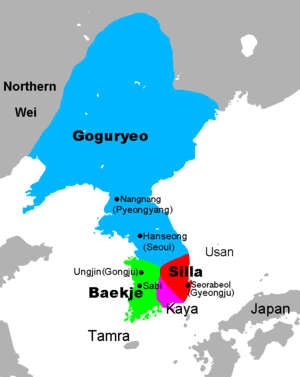Gaya language
| Gaya | |
|---|---|
| Kaya/Kara | |
| Native to | Gaya confederacy |
| Region | Korea |
| Era | extinct 7th century |
|
Buyeo languages? (Koreanic/Japonic)
| |
| Language codes | |
| ISO 639-3 |
pkc |
pkc | |
| Glottolog |
paek1234[1] |
 The Three Kingdoms of Korea, with Gaya in Pink. | |
Gaya (伽耶語, 가야어), also rendered Kaya or Karak, is the presumed language of the Gaya confederacy in southern Korea. It is supposedly attested from thirteen toponyms, but it cannot be certain that these reflect the Gaya language itself rather than an earlier language.[2] Only one word survives that is directly identified as being from the language of the Gaya confederacy.
Identity
The place names in question appear to be in a language related to Korean and Japanese. Beckwith classifies the Japonic family with toponymic pre-Kara as follows:[2] The linguistic scholar from South Korea, Jung Ho Wan, claimed that while it is only an assumption to say that Gaya's language, which is the only one left to this day, is similar to Japanese language, if the assumption is true, however, this suggests that not only Gaya's culture but also its language influenced the Yayoi who crossed over from the Korean Peninsula.[3]
It is not clear if this "pre-Kara" was related to the language of the later Gaya confederacy, of which only four words survive.[4] In volume 34 of the Samguk Sagi, a note for the word 旃檀梁 states that, "In the Kaya language, 'gate' is called 梁." The Chinese character ⟨梁⟩ was used to write the Silla word for 'ridge', which was ancestral to Middle Korean 돌 *twol 'ridge', suggesting that the Gaya word for 'gate' may have been pronounced something like twol. This looks similar to Old Japanese *two/tö (門/戸) (modern Japanese to, 戸), meaning 'door, gate'.[4][5][6]
The theory that Korean is related to Japanese has supporters due to similar grammatical features that have been elaborated upon by such researchers as Samuel E. Martin[7] and Roy Andrew Miller.[8]
Some of the common features are:[9]
- the languages are agglutinative,
- follow the SOV order,
- nouns and adjectives follow the same syntax,
- particles are post-positional,
- modifiers always precede modified words.
The two languages have previously been thought to not share any cognates (other than loanwords),[10] for their vocabularies do not phonetically resemble each other. However, a recent 2016 paper proposing a common lineage between Korean and Japanese traces around 500 core words that share a common origin. [11]
Some previous linguists have listed a tiny amount of translations which are perceived as phonetic parallels and cognates. This is exemplified in the following table:
| term | Korean(RRK) | Japanese(Hepburn) |
|---|---|---|
| we | uri | ore-ra |
| not | ani, an | -na(-i), -n(-u) |
| to scratch | geulg- | kak- |
| sun | hae | hi, -bi |
| water | mul | mizu |
| lake | mot | mizuumi |
| cloud | gureum | kumo |
| island | seom | shima |
| bear | gom | kuma |
| to be hard | gud- | kata- |
| bundle | dabal | taba |
Name
The name Gaya is Korean, from the modern transcription 加耶 (伽倻). However, it was difficult to render the phonological shape of words in the languages of Korea by the use of Chinese characters, since Hangul had not yet been invented, and thus a variety of historical forms are attested. (See Gaya confederacy.) Generally Gaya was transcribed as Kaya (加耶) or Karak (伽落), but the transcription in the oldest sources is Kara (加羅), and philological reconstruction points towards MC *kayia, from Ancient Chinese *kala = *kara.[2] Beckwith considers the pronunciation [kaɾa] "certain",[12] so the language is also known as Kara, for example in Ethnologue.
References
- ↑ Hammarström, Harald; Forkel, Robert; Haspelmath, Martin, eds. (2017). "Gaya". Glottolog 3.0. Jena, Germany: Max Planck Institute for the Science of Human History.
- 1 2 3 Beckwith, Christopher (2007). Koguryo, the Language of Japan's Continental Relatives. pp. 27–28.
- ↑ 가야의 언어와 문화 2007년 06월 27일 출간
- 1 2 Christopher I. Beckwith, Koguryo, BRILL 2007 p.40.
- ↑ Martine Irma Robbeets, Is Japanese Related to Korean, Tungusic, Mongolic and Turkic?, Otto Harrassowitz Verlag, 2005 p.867 n.203.
- ↑ Lee, Ki-Moon; Ramsey, S. Robert (2011). A History of the Korean Language. Cambridge University Press. p. §2.3.4, p.47.
- ↑ Martin 1966, 1990
- ↑ e.g. Miller 1971, 1996
- ↑ Sohn (2001), p. 29.
- ↑ Martin, Samuel (1990).
- ↑ Takenobu, Francis-Ratte, Alexander (2016). "Proto-Korean-Japanese: A New Reconstruction of the Common Origin of the Japanese and Korean Languages".
- ↑ Beckwith, Christopher I. (2009). Empires of the Silk Road: A History of Central Eurasia from the Bronze Age to the Present. Princeton University Press. p. 105. ISBN 978-0-691-13589-2.